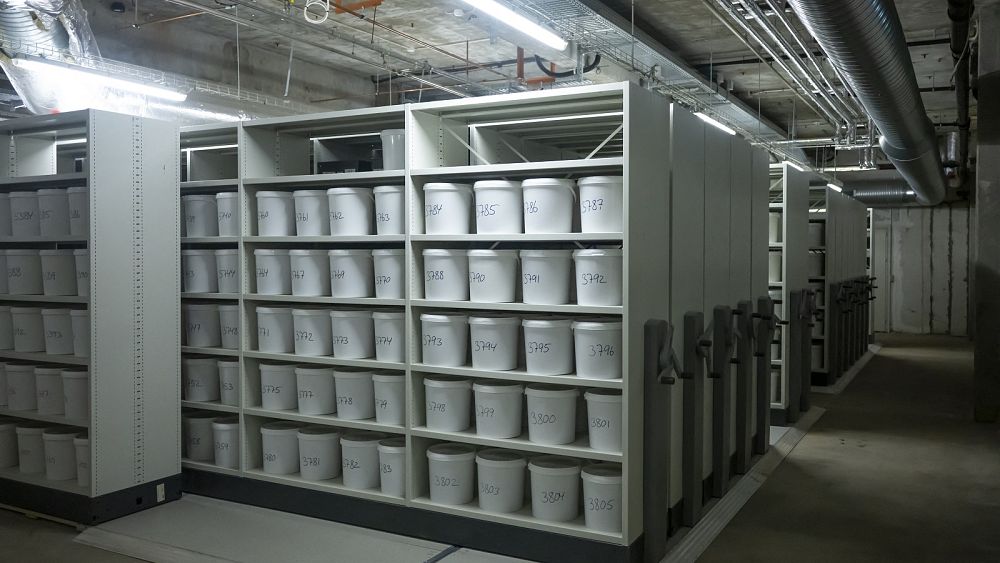
In the cold, grey basement of the University of Southern Denmark is a room with nearly 10,000 white plastic buckets with scribbled numbers on each one.
Walking through the aisles of rolling shelves on which the buckets are placed, there is not much there to tell you that this is the world’s biggest collection of brains.
Each bucket is like a Russian doll, containing a smaller, original yellow bucket to keep the contents from seeping out into the white container. And inside each yellow bucket is a brain preserved in formaldehyde solution that was harvested between 1945 and 1982.
The mastermind behind the grand collection was a prominent Danish physician Erik Strömgren and an Icelandic researcher Lárus Einarson.
They founded the Institute of Brain Pathology in 1945 in Risskov, western Denmark, hoping that future scientists and doctors will be able to examine the brains again at a later time when science has advanced.
A total of 9,479 brains were collected from psychiatric patients diagnosed with dementia, schizophrenia, mania, and depression.
The brains – extracted during autopsies – were sent from state mental hospitals across Denmark by post. They were then sitting in the boxes for a few weeks before being sliced into pieces and put in formaldehyde solution for preservation.
Work on the collection stopped due to financial reasons in 1982 and was eventually moved to another city, Odense, in 2017.
The specimens have been kept with books of records that contain information about each patient, the so-called “brain journals”. Researchers at the University of Southern Denmark are currently working to digitise these records so a wider community of scientists have access to them.
Experts say the collection offers great insights opportunities to researchers. Not only does it allow researchers to sample cases from different demographic groups but also to investigate the effects of modern psychiatric treatment since some of the brains are from people who never received any modern medical intervention.
A dark episode in Denmark’s history
Some experts, on the other hand, are keen to emphasise that the large-scale brain collection was only feasible since “the patients in psychiatry had very few rights”.
“You could get treated without saying yes to that particular treatment and patients were seen as not as equal to other Danes at the time,” said Jesper Vaczy Kragh, Senior Researcher in the Copenhagen Centre for Health Research in the Humanities (CoRe).
Jesper Vaczy Kragh
Senior Researcher, Copenhagen Centre for Health Research in the Humanities (CoRe)
“Most of the Danish institutions were part of the state psychiatry so these were state mental hospitals and there were no people from the outside who were asking questions about what went on in these state institutions,” added Kragh.
Autopsies are less commonly carried out nowadays because we have scanning techniques that allow us to know what has happened in the body, but also because “the way of thinking about individual rights have radically changed”.
“In the old days, an autopsy was a natural part of dying in a hospital,” Martin Wirenfeldt Nielsen, the head of the “Brain Collection” at the University of Southern Denmark, told Danish newspaper Kristeligt Dagblad.
“Today we think of the individual as inviolable. That we can decide everything, or at least most, about what happens to us ourselves. At that time, neither the patients themselves nor their relatives were necessarily asked for permission for an autopsy. It was just done,” he added.
When the Danish Ethics Council ruled in the early 1990s that the brains could be used for research, even though they were taken without the consent of the patients or their families, Denmark saw one of the first major ethical debates in its history.
The debate has since settled down, but books and films about conditions at state-run mental institutions have constantly reminded Danes that the government owes those patients an apology.
At the beginning of March 2023, the new Danish government concluded that those previously placed in special care should receive an apology later this year.
A total of 27,500 people were registered in various healthcare institutions between 1933 and 1980 in Denmark. The institutions were not prisons but often times the patients couldn’t leave.
An investigation carried out in April 2022 revealed that a large number of the patients had suffered assaults during the period.
It is believed that the patients had to undergo – among others procedures – forced sterilisation and lobotomy.
Among those who are expected to receive an apology are 500 Danish women who had undergone forced sterilisation and abortion at an institution on an island called Sprogø between the 1920s and 1960s.
For more on this story, watch the video in the media player above.
Video editor • Roselyne Min



